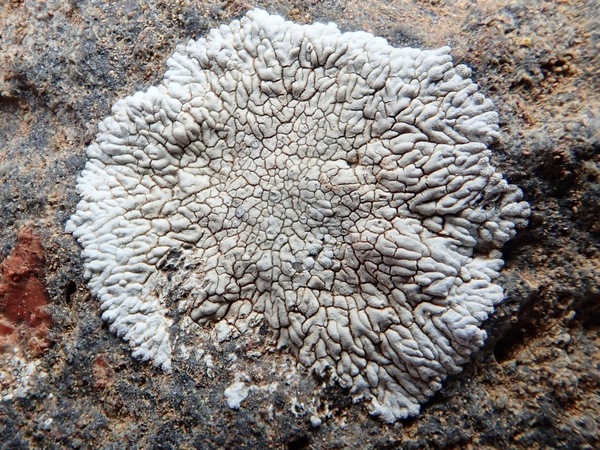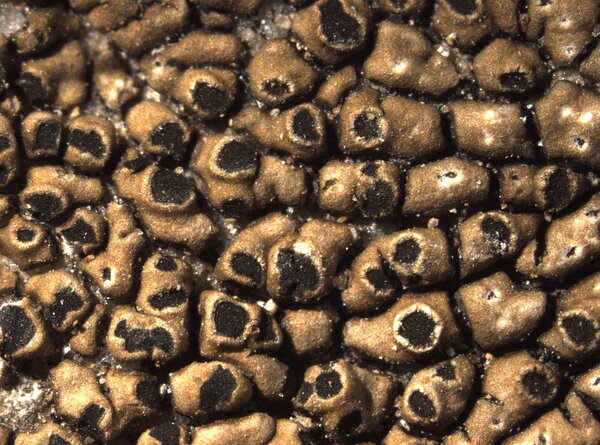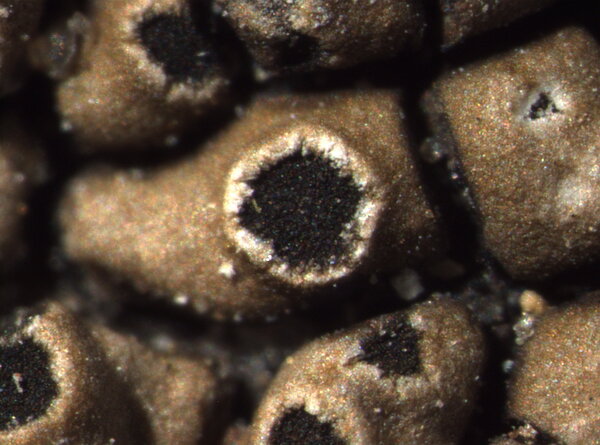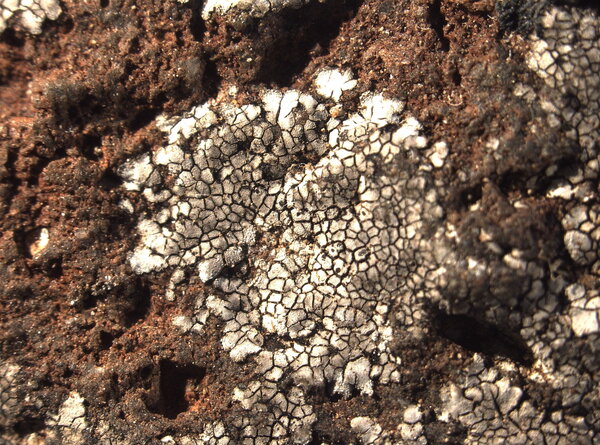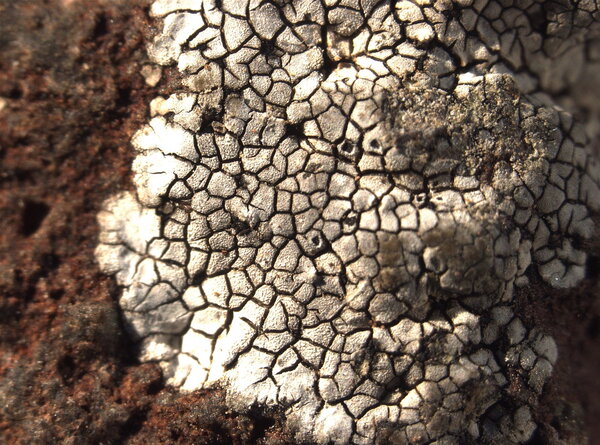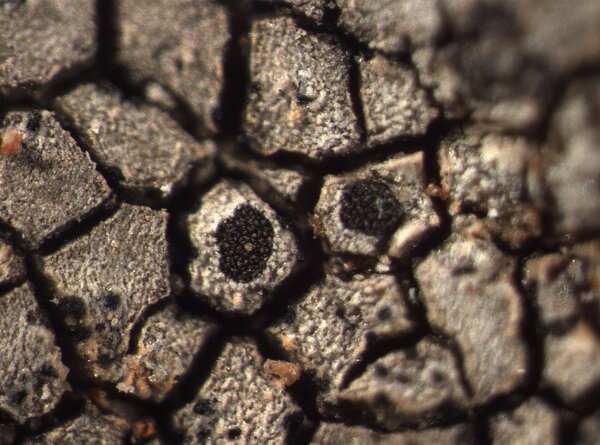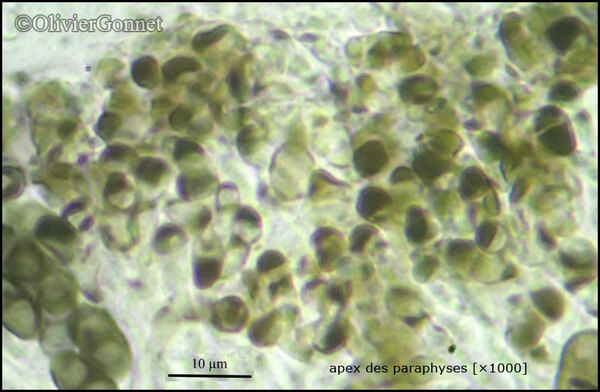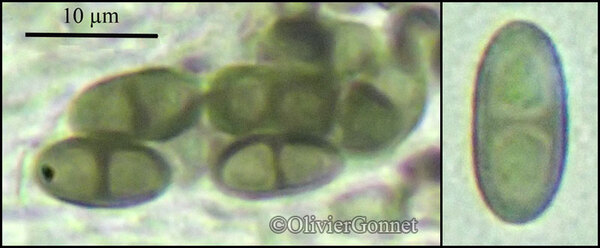Dimelaena radiata (Tuck.) Müll.Arg.
Flora, 67: 466, 1884. Basionym: Buellia radiata Tuck. - Lichens of California: 25, 1866
Synonyms: Catolechia radiata (Tuck.) Müll. Arg.; Rinodina radiata (Tuck.) Tuck.
Distribution:
Description: Thallus crustose-placodioid, episubstratic, whitish to pale grey and heavily pruinose or brown and mainly epruinose except sometimes in marginal parts, areolate in central parts, forming regular to irregular rosettes, the individual thalli often merging to cover large surfaces. Areoles 0.1-0.8 mm wide, mostly flat, developing on a dark hypothallus; marginal lobes 0.3-1 mm wide, mostly flat or slightly convex. Upper phenocortex pseudoparenchymatous, often with crystal inclusions; medulla white, of loosely interwoven hyphae, I+ blue. Apothecia frequent, at first cryptolecanorine and immersed in the thallus, then lecanorime and or more or less adnate, 0.1-0.8 mm across, with a black, sometimes white-pruinose, flat to slightly convex disc and a thin, sometimes finally excluded thalline margin. Epithecium yellowish brown to brown, 5-15 µm high; hymenium colourless, 50-85(-100) µm high, I+ blue; paraphyses simple or sparingly branched, (1-)2-3 µm thick at base, the apical cells 3-6 µm wide; hypothecium brown or dark brown, 75-200 µm high. Asci 8-spored, cylindrical-clavate, the apical dome K/I+ dark blue with a pale, conical-pointed apical cushion (axial mass), the wall I-, but the thin outer gel I+ blue, Bacidia-type. Ascospores 1-septate and slightly constricted at septum, thin-walled throughout, brown, ellipsoid, 8-12 x 5-8 µm, the wall distinctly ornamented, Beltraminia-type. Pycnidia black, immersed in the areoles, obpyriform. Conidia hyaline, simple, bacilliform, 7-11 x c. 1 µm. Photobiont chlorococcoid. Spot tests: K- or K+ yellow, C-, KC-, P- or P+ orange; medulla KC- or KC + fleeting pink. Chemistry: 3-chlorodivaricatic acid (major), divaricatic acid (traces), occasionally norstictic acid (minor), 3-chlorolecanoric, 3-chloronordivaricatic and 3-chloroisosubdivaricatic acids (all minor) (chemotype I); divaricatic acid (major), 3-chlorodivaricatic acid (traces) (chemotype II); 5-chlorodivaricatic acid (major), 3-chlorodivaricatic acid (minor) (chemotype III); psoromic acid, 2'-O-demethylpsoromic acid (chemotype IV); virensic acid (chemotype V).Note: a Mediterranean-Macaronesian species with a disjunction in W North America, also known from North Africa, the Iberian Peninsula and Corsica, growing on siliceous rocks in sunny, dry situations. To be looked for in the driest parts of Mediterranean Italy, especially in Sardinia.
Growth form: Crustose placodiomorph
Substrata: rocks
Photobiont: green algae other than Trentepohlia
Reproductive strategy: mainly sexual
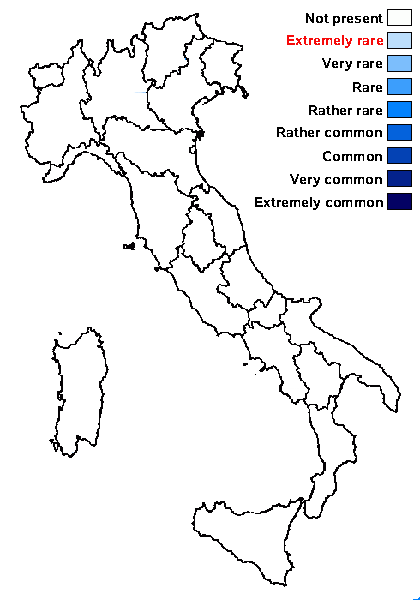
Predictive model
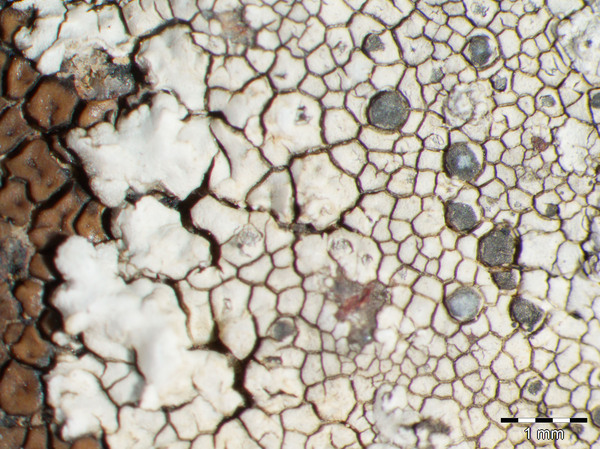
Harrie Sipman – Source http://www.bgbm.fu-berlin.de/sipman/Zschackia/AegeanLichens/CaloplacaAC.htm - As Caloplaca oasis
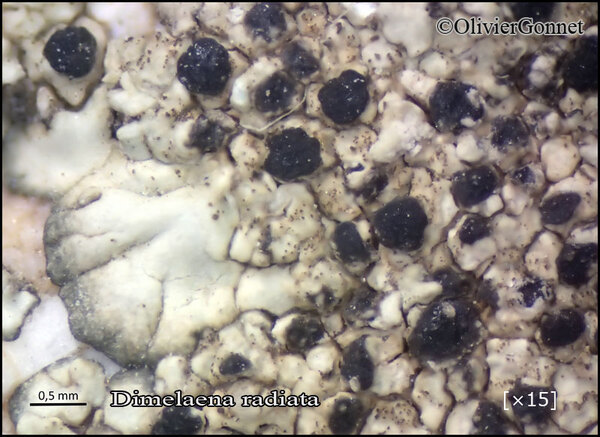
Courtesy Danièle et Olivier Gonnet - Source: https://www.afl-lichenologie.fr/Photos_AFL/Photos_AFL_D/Textes_D1/Dimelaena_radiata.htm
France, île Cavallo, alt. 10 m - Corse
5/12/2014
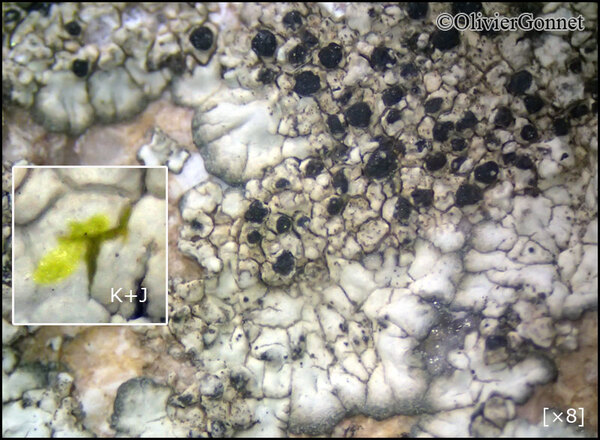
Courtesy Danièle et Olivier Gonnet - Source: https://www.afl-lichenologie.fr/Photos_AFL/Photos_AFL_D/Textes_D1/Dimelaena_radiata.htm
France, île Cavallo, alt. 10 m - Corse
5/12/2014

Courtesy Danièle et Olivier Gonnet - Source: https://www.afl-lichenologie.fr/Photos_AFL/Photos_AFL_D/Textes_D1/Dimelaena_radiata.htm
France, île Cavallo, alt. 10 m - Corse
5/12/2014
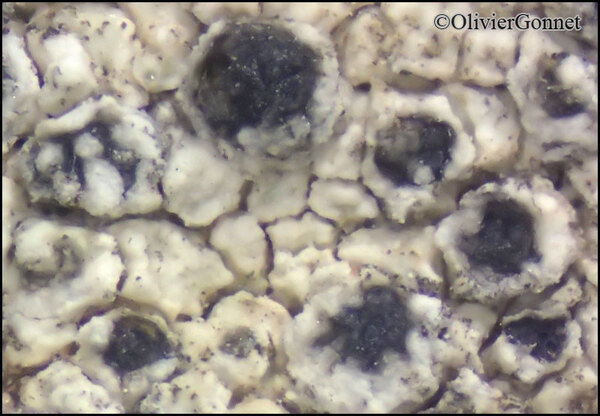
Courtesy Danièle et Olivier Gonnet - Source: https://www.afl-lichenologie.fr/Photos_AFL/Photos_AFL_D/Textes_D1/Dimelaena_radiata.htm
France, île Cavallo, alt. 10 m - Corse
5/12/2014

Courtesy Danièle et Olivier Gonnet - Source: https://www.afl-lichenologie.fr/Photos_AFL/Photos_AFL_D/Textes_D1/Dimelaena_radiata.htm
France, île Cavallo, alt. 10 m - Corse
5/12/2014

Courtesy Danièle et Olivier Gonnet - Source: https://www.afl-lichenologie.fr/Photos_AFL/Photos_AFL_D/Textes_D1/Dimelaena_radiata.htm
France, île Cavallo, alt. 10 m - Corse
5/12/2014
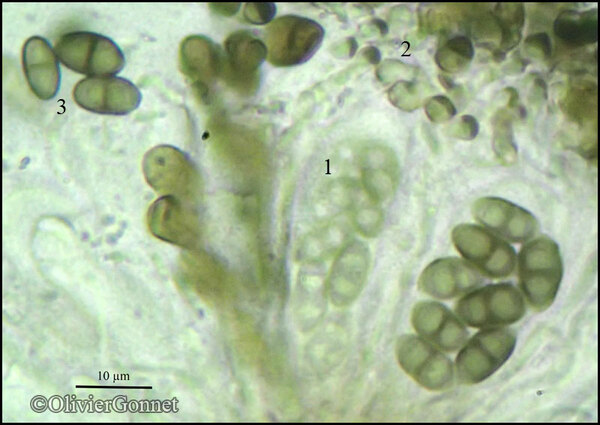
Courtesy Danièle et Olivier Gonnet - Source: https://www.afl-lichenologie.fr/Photos_AFL/Photos_AFL_D/Textes_D1/Dimelaena_radiata.htm
France, île Cavallo, alt. 10 m - Corse
5/12/2014
Growth form: Crustose placodiomorph
Substrata: rocks
Photobiont: green algae other than Trentepohlia
Reproductive strategy: mainly sexual

Predictive model

Harrie Sipman – Source http://www.bgbm.fu-berlin.de/sipman/Zschackia/AegeanLichens/CaloplacaAC.htm - As Caloplaca oasis

Courtesy Danièle et Olivier Gonnet - Source: https://www.afl-lichenologie.fr/Photos_AFL/Photos_AFL_D/Textes_D1/Dimelaena_radiata.htm
France, île Cavallo, alt. 10 m - Corse
5/12/2014

Courtesy Danièle et Olivier Gonnet - Source: https://www.afl-lichenologie.fr/Photos_AFL/Photos_AFL_D/Textes_D1/Dimelaena_radiata.htm
France, île Cavallo, alt. 10 m - Corse
5/12/2014

Courtesy Danièle et Olivier Gonnet - Source: https://www.afl-lichenologie.fr/Photos_AFL/Photos_AFL_D/Textes_D1/Dimelaena_radiata.htm
France, île Cavallo, alt. 10 m - Corse
5/12/2014

Courtesy Danièle et Olivier Gonnet - Source: https://www.afl-lichenologie.fr/Photos_AFL/Photos_AFL_D/Textes_D1/Dimelaena_radiata.htm
France, île Cavallo, alt. 10 m - Corse
5/12/2014

Courtesy Danièle et Olivier Gonnet - Source: https://www.afl-lichenologie.fr/Photos_AFL/Photos_AFL_D/Textes_D1/Dimelaena_radiata.htm
France, île Cavallo, alt. 10 m - Corse
5/12/2014

Courtesy Danièle et Olivier Gonnet - Source: https://www.afl-lichenologie.fr/Photos_AFL/Photos_AFL_D/Textes_D1/Dimelaena_radiata.htm
France, île Cavallo, alt. 10 m - Corse
5/12/2014

 INDEX FUNGORUM
INDEX FUNGORUM
 GBIF
GBIF
